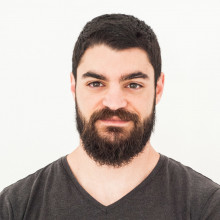

To: 24/05/2023 14:00
Electrical spin injection into semiconductors [1] is a pre-requisite for semiconductor spintronics, where the spin (in addition to the charge) of the carriers would carry information. A possible way to perform an efficient electrical spin injection is to use ferromagnetic metals (Co, CoFeB…) as spin injectors, and to cross the metal/semiconductor interface through a tunnel barrier (MgO, SiO2…). Among the possible systems, spin optoelectronic devices (spin light-emitting diodes [1], spin lasers and spin photodiodes), where the carrier spin can be converted into photon helicity (and vice-versa), have gained intensive interest in the last decade. The potential applications are optical free-space communication, 3D displays, biomedical analyses…. However, according to the optical selection rules for surface emitting devices, it is usually necessary to apply a strong external magnetic field in the range of a few Teslas on the conventional magnetic electrodes with in-plane magnetization in order to rotate it out-of-plane and inject spins oriented perpendicularly to the interface. A magnetic field of the same amplitude is also necessary to switch the magnetization and thus the light helicity.Using such large magnetic field is impossible for the practical applications. In this talk, progress on SpinLEDs based on Perpendicular Magnetic Anisotropy (PMA) CoFeB/MgO spin injectors will be presented, where spin injection occurs without the need of any external magnetic field. In particular, electrical spin injection into a single InAs/GaAs quantum dot will be evidenced at zero magnetic field [2], as well as electrical initialization of nuclear spins in the dot. Finally, we will present very recent advances concerning the switching of the magnetic electrode, that can be performed by electrical means. The switching relies on the Spin Transfer Torque (STT) effect using an auxiliary spin current generated by charge/spin conversion(by Spin Hall Effect SHE) of a lateral auxiliary charge current propagating in the Ta/CoFeB electrode. Large circular polarization of the light (>30%) emitted by the spinLED, and robust electrical switching of the photon helicity have been demonstrated at room temperature [3].
[1] R. Fiederling et al., Nature 402, 787 (1999)
[2] F. Cadiz et al., Nanolett. 18, 2381 (2018)
[3] Y. Lu et al., March Meeting, Las Vegas (2023)
This project receives funding in the European Commission’s Horizon 2020 Research Programme under Grant Agreement Number 818087.
To: 31/05/2023 14:00
The operation of a lithium-ion battery (LIB) cell is governed by the much desirable periodicity and reversibility of lithium ions extraction and insertion mechanisms, as they are transported between the electrodes, keeping the capacity retention high. Unavoidably, there is an irreversible part manifested as capacity loss due to solid electrolyte interphase (SllEI) growth, contact loss, active material deterioration and lithium inventory loss, factors that are extensively documented and studied, mainly through the electric parameters of current, voltage and charge from cell level to commercial operating battery packs. Only recently the interest towards probing the mechanical behavior has grown and the criticality of such information, in understanding the inner workings of secondary battery cells, has been appreciated. Parameters such as the mechanical stress, volume expansion and pressure are gaining ground in State of Charge (SoC) and State of Health (SoH) monitoring. From the comparison of stored charge, incremental capacity peak intensity and position and state of health against pressure it was revealed that there is a strong connection between pressure and peak intensity.
Position Description
Development of smart robotic system for assembling flexible power electronic RF components.
For the full announcement, follow the link "Related Documents"
Required Qualifications
- BSc in Robotic and electronic engineering
- MSc in engineering
- Proven experience in the use of EAGLE software
- Proven experience in the use of C/C++ and Java
- Proven experience in the use of micro controller platforms
- Proven experience in the use of 3D design software
- At least 10 years working experience
Desirable Qualifications
Proven participation to funded research projects
Application Procedure
Interested candidates who meet the aforementioned requirements are kindly asked to submit their applications to the address (hr@iesl.forth.gr), with cc to Dr George Konstantinidis (aek@physics.uoc.gr).
In order to be considered, the application must include:
- Application Form (Form Greek or Form English to the left)
- Detailed curriculum vitae (CV) of the candidate
- Scanned Copies of academic titles
Appointment Duration
6 monthsPosition Description
- Ανάπτυξη καινοτόμων μεθοδολογιών και διατάξεων οπτικής φασματοσκοπίας και αλγορίθμων στατιστικών μοντέλων μηχανικής μάθησης για εφαρμογή στον έλεγχο ποιότητας και ασφάλειας προϊόντων αγροδιατροφής
- Διεξαγωγή πειραματικών μετρήσεων σύμφωνα με τις απαιτήσεις του έργου (π.χ. φασματοσκοπικές μελέτες δειγμάτων προϊόντων αγροδιατροφής, σχεδιασμός πειραματικών διατάξεων, κ.α.)
- Ανάλυση και αξιολόγηση πειραματικών αποτελεσμάτων (π.χ. με χρήση λογισμικού στατιστικής επεξεργασίας δεδομένων)
- Διάχυση των αποτελεσμάτων του έργου (π.χ. μέσω δημοσιεύσεων σε επιστημονικά περιοδικά, παρουσιάσεων σε συνέδρια, αναρτήσεων σε κοινωνικά δίκτυα ή στην ιστοσελίδα του έργου, κ.α.)
- Συμμετοχή στη διαχείριση του έργου και τη σύνταξη εκθέσεων προόδου
- Διασφάλιση της καλής λειτουργίας του εξοπλισμού του εργαστηρίου
- Συμμετοχή σε συναντήσεις με τα μέλη του εργαστηρίου και με εξωτερικούς συνεργάτες • Συμμετοχή στην εκπαίδευση και επίβλεψη προπτυχιακών και μεταπτυχιακών συνεργατών
Για το πλήρες κείμενο της πρόσκλησης ακολουθήστε τον σύνδεσμο 'Related Documents'
Required Qualifications
- Πτυχίο Θετικών Επιστημών (Φυσικής, Χημείας, Επιστήμης Υλικών)
- Μεταπτυχιακό Δίπλωμα Ειδίκευσης (Φυσικής, Χημείας, Επιστήμης Υλικών) με έμφαση στη χρήση μεθόδων οπτικής φασματοσκοπίας
- Εγγεγραμμένος/η σε πρόγραμμα PhD/διδακτορικό πρόγραμμα ημεδαπής
- Γνώση και εμπειρία στην εφαρμογή φασματοσκοπικών τεχνικών απορρόφησης και φθορισμού και λήψης φασμάτων σε δείγματα τροφίμων
- Γνώση και εμπειρία στην ανάλυση και αξιολόγηση οπτικών φασμάτων με χρήση του στατιστικού πακέτου λογισμικού MATLAB PLS Toolbox
- Συμμετοχή του/της υποψηφίου σε διεθνή συνέδρια
Application Procedure
Στο φάκελο υποβολής της πρότασης θα πρέπει να εμπεριέχονται τα ακόλουθα:
- Αίτηση (Form Greek στην αριστερή στήλη) με αναφορά στον κωδικό της θέσης και στο όνομα του προγράμματος
- Αναλυτικό Βιογραφικό Σημείωμα
- Ευκρινή φωτοαντίγραφα τίτλων σπουδών
- Πρόσφατη βεβαίωση σπουδών υποψήφιου διδάκτορα
ΥΠΟΒΟΛΗ ΠΡΟΤΑΣΕΩΝ
Οι ενδιαφερόμενοι καλούνται να υποβάλουν τις αιτήσεις τους και όλα τα απαραίτητα δικαιολογητικά, ηλεκτρονικά στη διεύθυνση hr@iesl.forth.gr με κοινοποίηση (cc): στον Δρ Μ. Βελεγράκη (vele@iesl.forth.gr). Οι αιτήσεις θα πρέπει να αποσταλούν με την ένδειξη: «Αίτηση στο πλαίσιο του προγράμματος OLiPoT, της πρόσκλησης εκδήλωσης ενδιαφέροντος με Α.Π. … και κωδικό θέσης … » (όπως αυτός αναφέρεται στον Πίνακα του Παραρτήματος).
Appointment Duration
3,5 μήνεςPosition Description
- Διεξαγωγή πειραματικών μετρήσεων σύμφωνα με τις απαιτήσεις του έργου (π.χ. φασματοσκοπικές μελέτες δειγμάτων προϊόντων αγροδιατροφής και συναφών χημικών ουσιών, σχεδιασμός πειραματικών διατάξεων, κ.α.)
- Ανάλυση πειραματικών αποτελεσμάτων (π.χ. με χρήση υφιστάμενου λογισμικού στατιστικής επεξεργασίας δεδομένων)
- Διάχυση των αποτελεσμάτων του έργου (π.χ. μέσω δημοσιεύσεων σε επιστημονικά περιοδικά, παρουσιάσεων σε συνέδρια, αναρτήσεων σε κοινωνικά δίκτυα ή στην ιστοσελίδα του έργου, κ.α.)
- Συμμετοχή στη διαχείριση του έργου και τη σύνταξη εκθέσεων προόδου
Required Qualifications
- Πτυχίο Θετικών Επιστημών (Φυσικής, Χημείας, Επιστήμης Υλικών)
- Μεταπτυχιακό σε θέματα οπτοηλεκτρονικής
- Γνώση και τουλάχιστον 5ετη εργαστηριακή εμπειρία στη χρήση τεχνικών λέιζερ σε θέματα φασματοσκοπίας
- Γνώση και τουλάχιστον 5ετη εργαστηριακή εμπειρία στην ανάλυση και αξιολόγηση φασματοσκοπικών δεδομένων
- Γνώση και εμπειρία στην χρήση στατιστικών πακέτων λογισμικού ανάλυσης δεδομένων οπτικής φασματοσκοπίας
- Τουλάχιστον 5 δημοσιεύσεις σε διεθνή επιστημονικά περιοδικά με κριτές
- Τουλάχιστον 3 δημοσιεύσεις σε συνέδρια
Application Procedure
Στο φάκελο υποβολής της πρότασης θα πρέπει να εμπεριέχονται τα ακόλουθα:
- Αίτηση (Form Greek στην αριστερή στήλη) με αναφορά στον κωδικό της θέσης και στο όνομα του προγράμματος
- Αναλυτικό Βιογραφικό Σημείωμα
- Ευκρινή φωτοαντίγραφα τίτλων σπουδών
ΥΠΟΒΟΛΗ ΠΡΟΤΑΣΕΩΝ
Οι ενδιαφερόμενοι καλούνται να υποβάλουν τις αιτήσεις τους και όλα τα απαραίτητα δικαιολογητικά, ηλεκτρονικά στη διεύθυνση hr@iesl.forth.gr με κοινοποίηση (cc): στον Δρ Μ. Βελεγράκη (vele@iesl.forth.gr). Οι αιτήσεις θα πρέπει να αποσταλούν με την ένδειξη: «Αίτηση στο πλαίσιο του προγράμματος OLiPoT, της πρόσκλησης εκδήλωσης ενδιαφέροντος με Α.Π. … και κωδικό θέσης … » (όπως αυτός αναφέρεται στον Πίνακα του Παραρτήματος).
Appointment Duration
3,5 μήνεςPosition Description
- Εφαρμογή καινοτόμων μεθοδολογιών και διατάξεων οπτικής φασματοσκοπίας για τον έλεγχο ποιότητας και ασφάλειας προϊόντων αγροδιατροφής
- Ανάλυση και αξιολόγηση των πειραματικών αποτελεσμάτων
- Διάχυση των αποτελεσμάτων του έργου (π.χ. μέσω δημοσιεύσεων σε επιστημονικά περιοδικά, παρουσιάσεων σε συνέδρια, αναρτήσεων σε κοινωνικά δίκτυα ή στην ιστοσελίδα του έργου, κ.α.)
- Συμμετοχή στη διαχείριση του έργου και τη σύνταξη των προβλεπόμενων δελτίων και εκθέσεων προόδου
- Επίβλεψη και καθοδήγηση προπτυχιακών και μεταπτυχιακών φοιτητών
- Συμμετοχή σε συναντήσεις με τα μέλη του εργαστηρίου και με εξωτερικούς συνεργάτες
Για το πλήρες κείμενο της πρόσκλησης ακολουθήστε τον σύνδεσμο 'Related Documents'
Required Qualifications
- Διδακτορικός τίτλος Μηχανικού ή Φυσικού σε πεδίο σχετικό με την εφαρμογή φασματοσκοπίας λέιζερ
- Γνώση και τουλάχιστον 5ετη εργαστηριακή εμπειρία στη χρήση φασματοσκοπίας λέιζερ και στην ανάλυση και αξιολόγηση φασματοσκοπικών δεδομένων
- Ερευνητική εμπειρία σε θέματα που σχετίζονται με εφαρμογές φασματοσκοπίας στην ανάλυση προϊόντων αγροδιατροφής
- Τουλάχιστον 5 επιστημονικές δημοσιεύσεις σχετικές με θέματα εφαρμογών φασματοσκοπίας στην ανάλυση προϊόντων αγροδιατροφής σε επιστημονικά περιοδικά ή σε συνέδρια
- Εμπειρία στην διαχείριση ερευνητικών έργων
Application Procedure
Στο φάκελο υποβολής της πρότασης θα πρέπει να εμπεριέχονται τα ακόλουθα:
- Αίτηση (Form Greek στην αριστερή στήλη) με αναφορά στον κωδικό της θέσης και στο όνομα του προγράμματος
- Αναλυτικό Βιογραφικό Σημείωμα
- Ευκρινή φωτοαντίγραφα τίτλων σπουδών
ΥΠΟΒΟΛΗ ΠΡΟΤΑΣΕΩΝ
Οι ενδιαφερόμενοι καλούνται να υποβάλουν τις αιτήσεις τους και όλα τα απαραίτητα δικαιολογητικά, ηλεκτρονικά στη διεύθυνση hr@iesl.forth.gr με κοινοποίηση (cc): στον Δρ Μ. Βελεγράκη (vele@iesl.forth.gr). Οι αιτήσεις θα πρέπει να αποσταλούν με την ένδειξη: «Αίτηση στο πλαίσιο του προγράμματος OLiPoT, της πρόσκλησης εκδήλωσης ενδιαφέροντος με Α.Π. … και κωδικό θέσης … » (όπως αυτός αναφέρεται στον Πίνακα του Παραρτήματος).
Appointment Duration
3,5 μήνεςPosition Description
Quantum Key Distribution and Physical Unclonable Functions.
In the framework of HellasQCI, the candidate is expected to work in aspects of quantum cryptography, focusing mainly on quantum key distribution (QKD) protocols, and physical unclonable functions. The candidate will have the opportunity to interact with QKD devices, to participate in the implementation of the local HellasQCI network, as well as in the demonstration of certain use cases of QKD. Finally, he/she will be involved in training activities.
For the full announcement, follow the link "Related Documents"
Required Qualifications
- Undergraduate degree in Physics, Electrical Engineering or similar
- Background in Quantum Optics or Quantum Photonics
- Recommendation Letters
- Programming skills (preferably Python, or Matlab or C++)
Desirable Qualifications
Very good knowledge of English
Application Procedure
Interested candidates who meet the aforementioned requirements are kindly asked to submit their applications to the address (hr@iesl.forth.gr), with cc to Dr George Nikolopoulos (nikolg@iesl.forth.gr).
In order to be considered, the application must include:
- Application Form (Form Greek or Form English to the left)
- Detailed curriculum vitae (CV) of the candidate
- Scanned Copies of academic titles
- Certificate for enrollment in a master’s program
Appointment Duration
12 months


